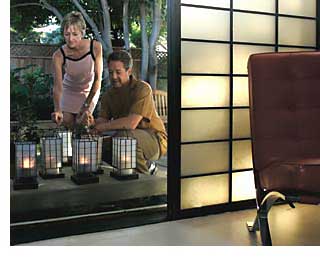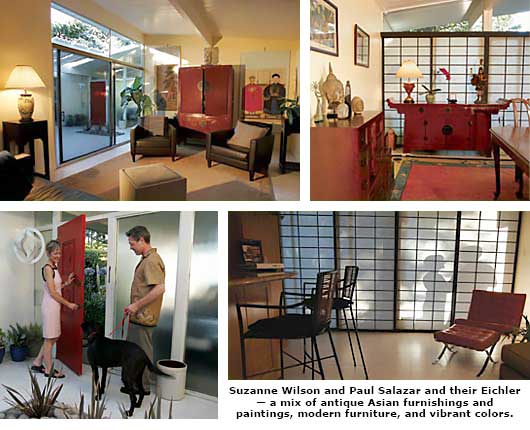East Meets West: Asian Aesthetic
 Much can be gained by adding an Asian touch to a mid-century modern home: drama, texture, color, a sense of history and tradition—not to mention the beauty and intellectual stimulation provided by true works of art. But for many Eichler owners, it all comes down to tranquility.
Much can be gained by adding an Asian touch to a mid-century modern home: drama, texture, color, a sense of history and tradition—not to mention the beauty and intellectual stimulation provided by true works of art. But for many Eichler owners, it all comes down to tranquility.
"It really lends a sense of tranquility that directly comes from the Asian pieces," says Suzanne Wilson, of the Asian theme she and her husband Paul Salazar adopted for their Eichler home in San Jose.
Their atrium home is a beautiful blend of authentic Japanese, Chinese, and Thai antique furnishings, 19th century Asian paintings, a few Asian reproductions used as accent pieces, and modern furniture. The Asian pieces work well with the home's minimalist lines and light-colored walls.
Especially effective are the shoji screens that allow Suzanne and Paul to control the light and views from their walls of windows. "They give a feeling of calm," Suzanne says, "a really nice dappling of light throughout the day." Gerry Gassman and Suzanne Boxer-Gassman, who live in a Claude Oakland atrium model in Sunnyvale, also appreciate the Asian sense of repose. "There's a certain inner peace and a not-too-cluttered look," Gerry says.
In San Jose, Steve Murphy uses Japanese antiques to create an artful blend of modern and traditional. "We just love the quiet simplicity of Japanese design," he says.
And in San Mateo Highlands, Barry and Rosemary Brisco turned their Eichler into a Zen-like, minimalist paradise.
Repose with a splash of color
Working without an interior designer, it took Suzanne Wilson and Paul Salazar three years to convert their Eichler atrium home into a quiet, meditative space—that is enlivened nonetheless with splashes of color and artwork that, like any real art, rewards close attention.
"We just threw together things we like," Wilson says.
Wilson, who grew up in a home filled with Japanese and Chinese antiques, found wonderful examples at shops in San Jose and San Francisco. Antique teakwood chests provide colorful accents in red against their light-colored walls—and harmonize with the color of their home's red door.
"I like the character of some of the older pieces," she says. "It doesn't bother me that the wood warps a little bit. It becomes a house with more character rather than a showroom."
In a sitting area off the atrium, a 19th century Chinese 'ancestor scroll' showing a patriarch and his consort, and a hundred-year scroll of a horse in a landscape create a room that is truly special. In the dining room, a flared-top Chinese chest from the 19th century is topped by a statue of St. Michael also from the 19th century—but from Mexico. Eclecticism has its place.
"I think it's very easy to combine simple modern furniture with lacquered pieces, and with very simple or with more decorative Asian art," Wilson says. "It's something that comes together as a jigsaw very easily."

Asian artifacts, modern art
Gerry Gassman loves his home's 'square-doughnut design,' with living spaces and bedrooms arrayed around the atrium. The décor reflects his interests in art, nature, and Asia, which he has visited several times.
The atrium is filled with plants typical of a Japanese garden—low shrubs, a Japanese maple. But then there's the uncharacteristic bougainvillea. There are also modern ceramic bowls, an abstract canvas by the painter (not the actor) Don Johnson and, in the corner, an immense Asian grinding stone. Mexican tile serves as flooring in the atrium, kitchen and adjoining sitting area that Gassman uses for informal dining.
Besides modern art and Asian objects, Gassman collects coral, and its otherworldly, starkness provides a touch of nature. Much of his modern art has an Oriental effect as well, including a textile piece in the sitting area that recalls a Chinese scroll.
The home's light-filled living room features an immense tansu next to a figure of a carp that seems to be leaping from a pond. Two wooden Chinese foo dogs cavort atop the dining room table. Gassman plays up the Japanese theme in the library by having custom cabinetry built tansu-style.
Gerry and wife Suzanne love their home at night, when hidden spotlights highlight the art, making it visible from every room in the house. Guests are charmed. "Eichlers are a great home for art," Gerry says. "Art and people."

Japanese beauty in hiding
From the street, Steve and Nancy Murphy's Eichler looks like any other on the block. Only a modest stone lantern and the raked gravel in the parking strip suggest what's inside.




